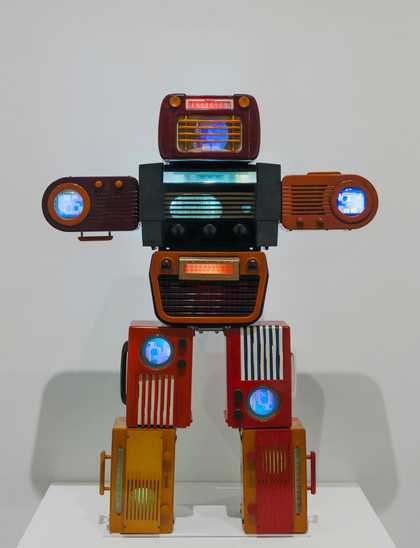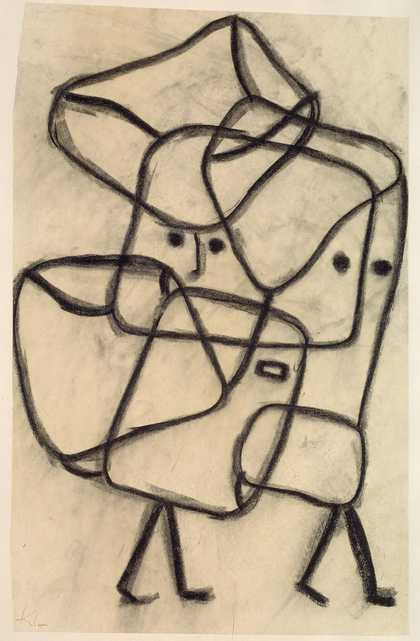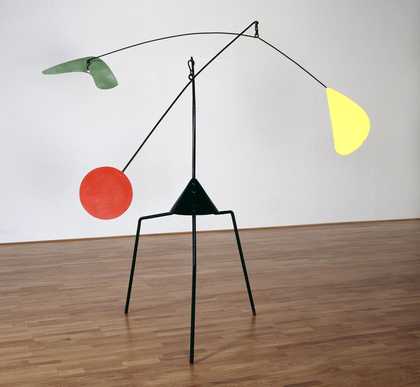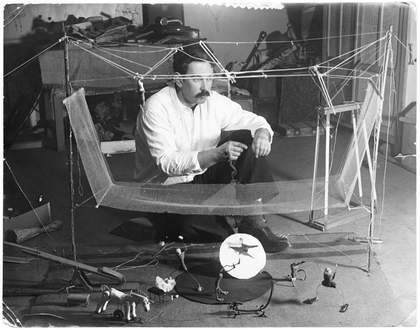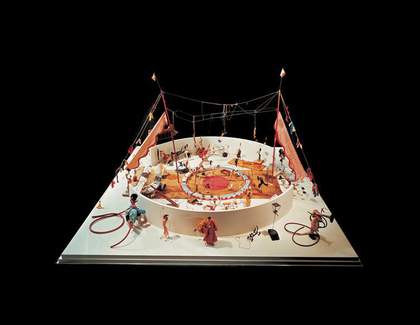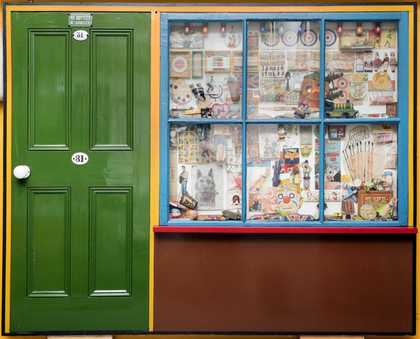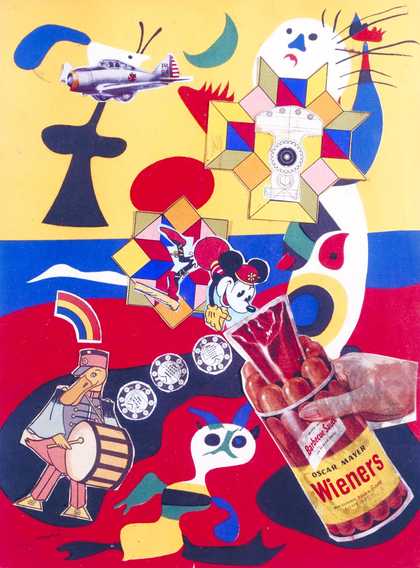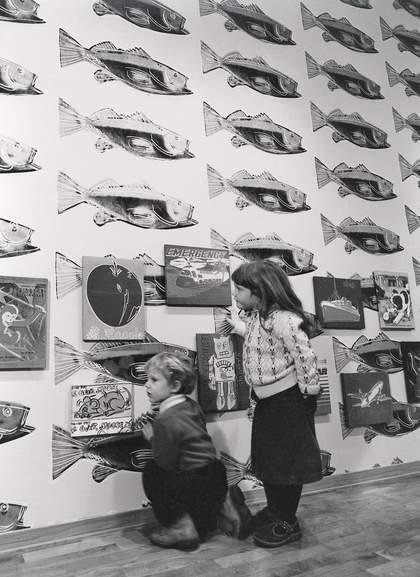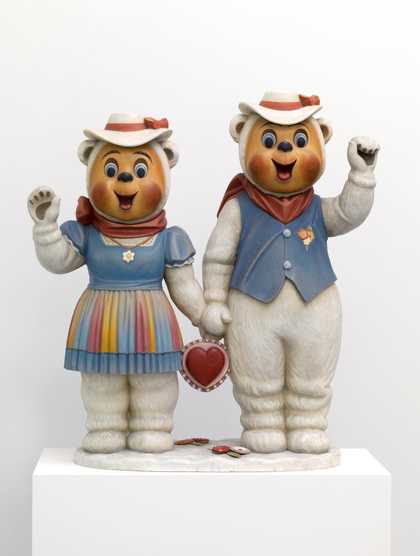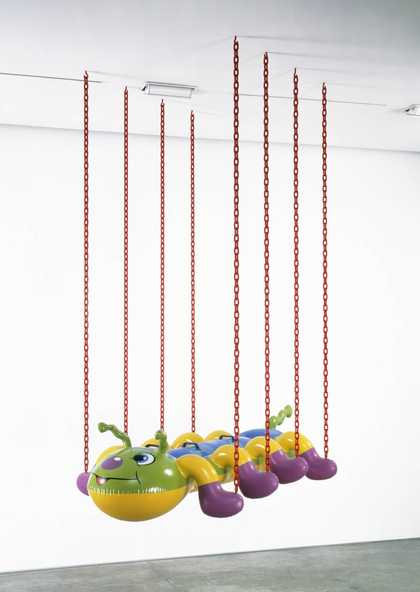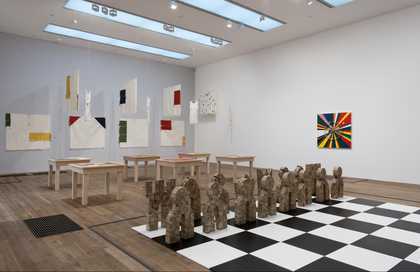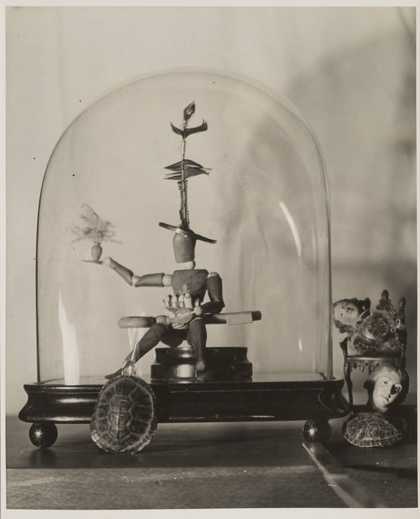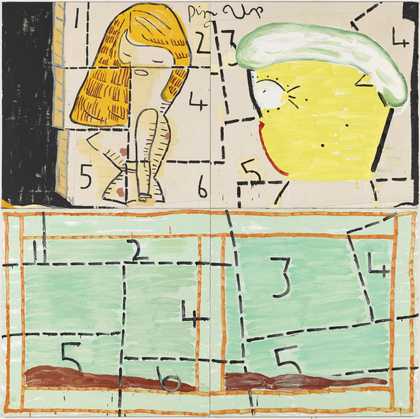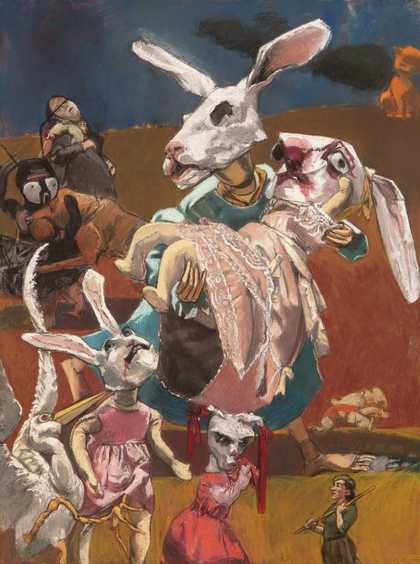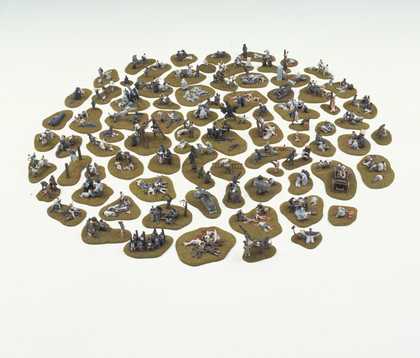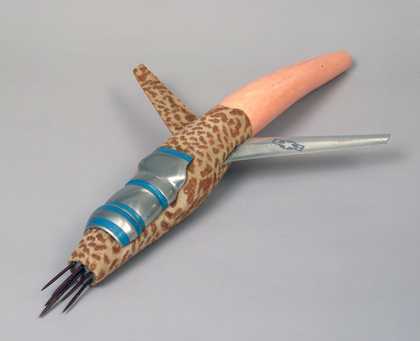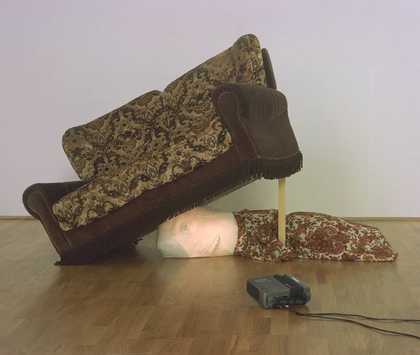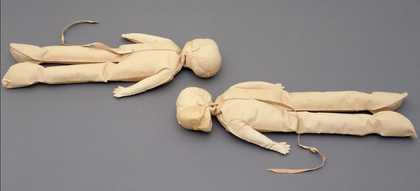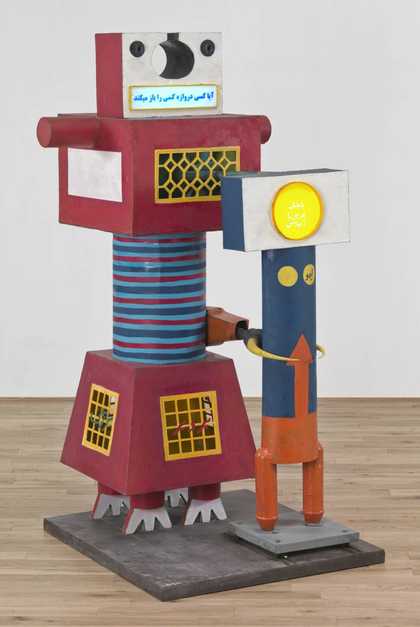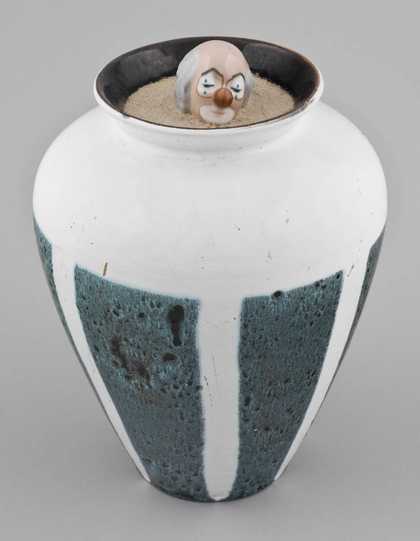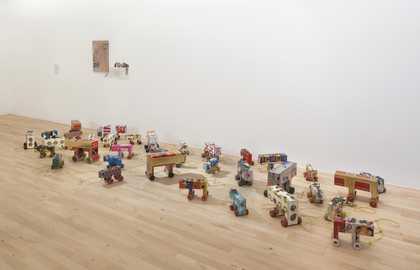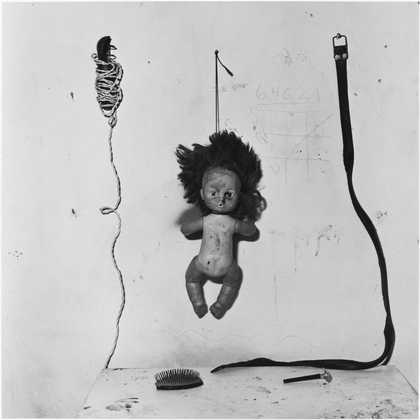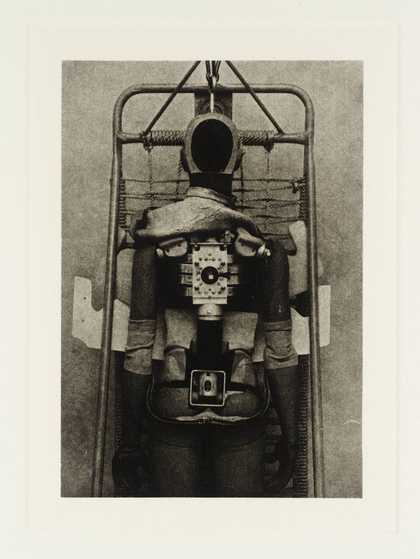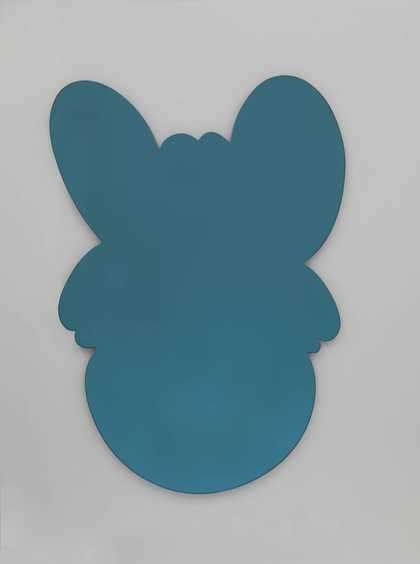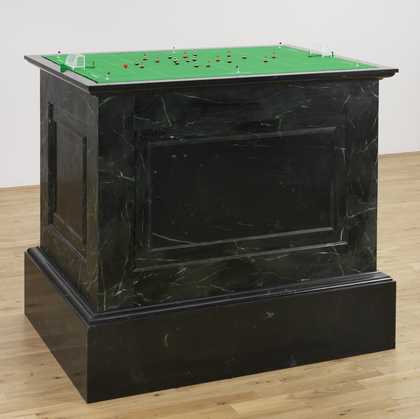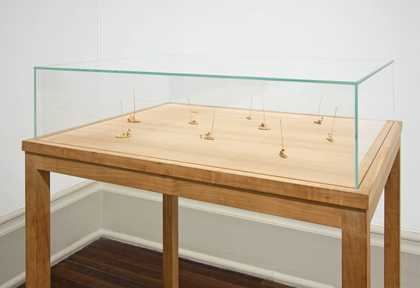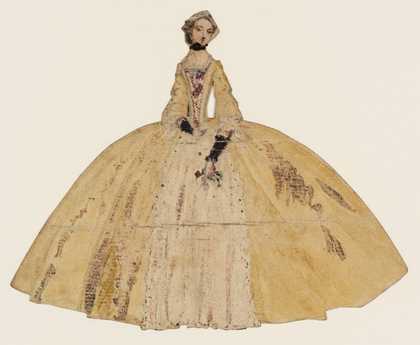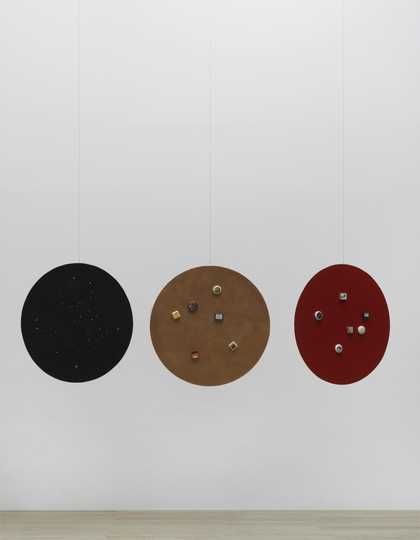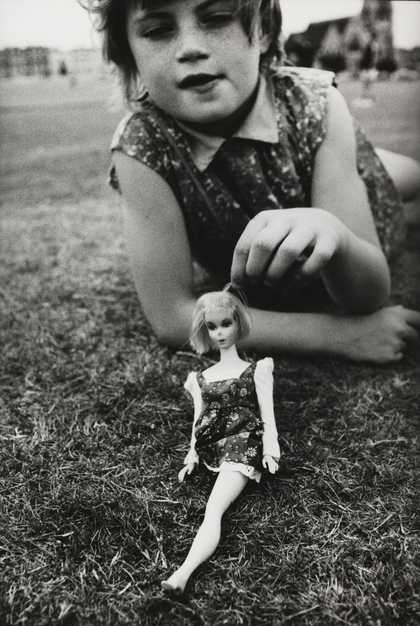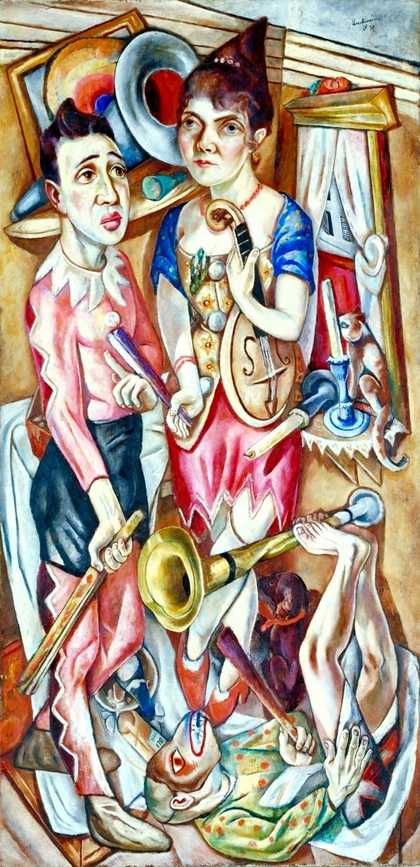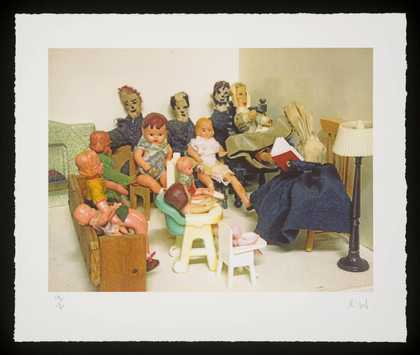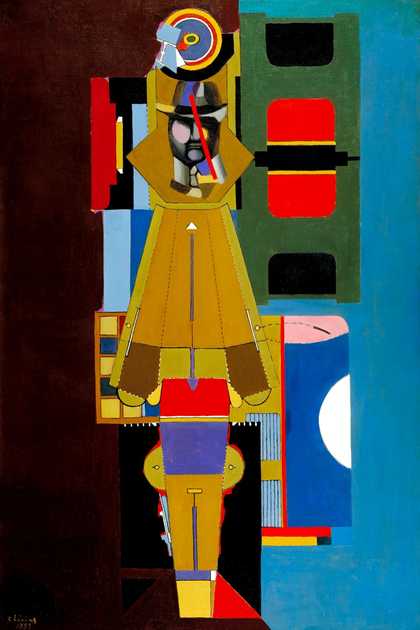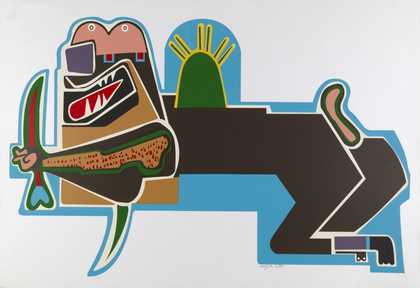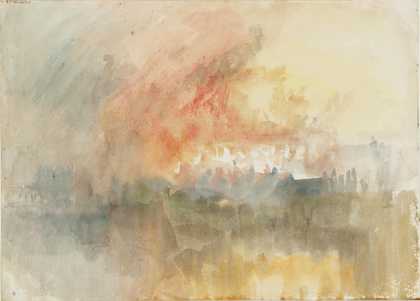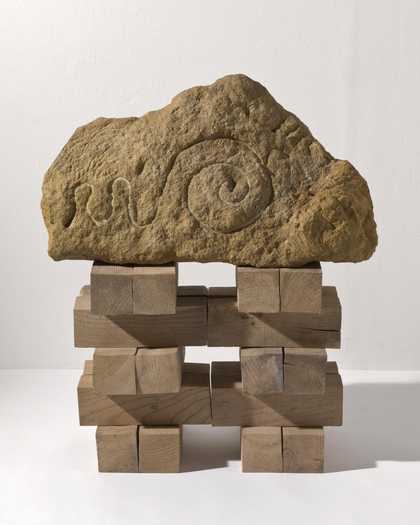Pop Art
In the 1950s and 1960s artists in America, Britain and around the world started using all sorts of things from popular culture in their art. They wanted their art to reflect the everyday lives and interests of contemporary society. (Rather than being about the classical subjects or formal ideas to do with colour, line and tone that they were taught at art school.)
Eduardo Paolozzi’s Bunk collages, made from photographs from magazines, comics, and advertisements include pictures of toys. The simple shapes and bright colours of Peter Phillips’s The Entertainment Machine 1961 are inspired by the games machines found in amusement arcades.
In 1983 Andy Warhol exhibited 128 paintings of toys, including a drumming panda, an airplane, a parrot and a spaceship, at a gallery in Zurich.
He made these paintings especially for children and hung them low on the gallery walls where children could see them. The Toy Paintings are made of three bold colours, overlaid to make it seem as though they should be looked at through 3-D glasses.
Jeff Koons: Bigging toys up!
Like the pop artists, Jeff Koons uses themes and subjects from popular culture in his work including toys, ornaments and advertising. He employs skilled craftspeople to recreate these everyday objects. By making them on a huge scale, he encourages us to find value in cheap, everyday things.
Caterpillar (with chains) 2003 is from a series of sculptures called Popeye. Popeye is a popular character in an American comic strip. The sculptures and paintings in the series focus on toys. The caterpillar looks exactly like a huge inflatable pool toy. But it is in fact cast in aluminium and coated in shiny, bright paint. Koons described the caterpillar, as well as the other pool toy animals in this series (which includes dolphins and lobsters), as being about ‘celebration and childhood’.
The most important thing to me is the preservation of the object – the sense that it has been created to survive and that its longevity is certain.
Jeff Koons
The sculptures from this series are often made up of very different elements that are unsettling. The caterpillar looks weightless but is suspended from eight bright red steel chains. The chains suggest imprisonment or entrapment. The Popeye sculptures also seem to comment on themes relating to commerce and leisure as with the earlier Banality series. The chains could suggest that we are shackled to shopping and commodities. Koons however says that his choice of materials and the appearance of the sculptures are about preservation. He wants to make sure that these fragile childhood objects survive.
Meschac Gabba’s Game Room
Artist Meschac Gaba also ‘bigs up’ toys for his Game Room. Game Room is part of a larger installation, Museum of Contemporary African Art. In creating this installation Gaba wanted to address his feeling that in Western Museums there was no place for African art. The aim of the work is also to broaden the idea of what a museum should or could be. By including a games room as well as a Humanist Space, Marriage Room and Music Room, Gaba’s museum is a space not only for the contemplation of objects, but for sociability, study and play. Game Room is dominated by a huge chess set. Banners with squares of bright colours look like the squares on a board game. Visitors to Game Room can play with sliding puzzle tables, reconstructing the flags of Chad, Angola, Algeria, Senegal, Seychelles and Morocco.
Power Toys: toys with a message
Artists sometimes use toys in their art to put across a powerful message.
Gender politics
Cindy Sherman’s Doll Clothes is a film work featuring herself as a paper doll that has come to life. The doll tries on lots of outfits in front of a mirror. After each outfit change a hand appears from the corner of the screen, putting the doll and her dress back in their plastic album sleeves. The repetition of posing followed by powerlessness reflects Sherman’s fascination with the politics of identity and representation, particularly in relation to women.
Claude Cahun was a poet, writer and journalist as well as an artist. They were associated with the surrealist movement. These two photographs are from a series Cahun created showing assemblages that feature a bell jar and a wooden mannequin. Cahun uses these assemblages to explore gender stereotypes. In one photograph the mannequin is feminised with a lock of blonde hair. In the other it has a tall headdress and is surrounded by tools relating to power. The figures echo Cahun’s performative self-portraits in which they disrupts feminine stereotypes.
Sarah Lucas makes sculptures from an unexpected range of everyday materials, such as worn furniture, clothing, cigarettes, fruit and vegetables. Pauline Bunny is made from nylon tights stuffed with cotton wadding, a toy-making process often used to make rag dolls. The figure is clipped to an office chair. The limp, floppy rag-doll form contrasts the fantasy of the glamorous ‘bunny girl’.
Artist Rose Wylie also explores how women are represented in her painting, Pin-Up and Porn Queen Jigsaw 2005. The pin-up on the left is based on the actress Marilyn Monroe in the film The Misfits 1961. The head on the right is based on the head of former porn star Annabel Chong. By presenting the women as a jigsaw puzzle, Wylie is perhaps suggesting how images of women are manipulated. As jigsaw pieces, they are objects that are slotted into their place.
Toys and war
Paula Rego used a photograph in a newspaper taken during the 2003 Iraq war as the source for her pastel drawing War 2003. Rego transformed the original image, using a cast of rabbits and other hybrid creatures. Rego often uses toys and other hybrid figures to explore themes of violence and sexuality. By transforming the people in this image into toy-like rabbits, objects associated with childhood and innocence, the grotesque nature of war is emphasised.
In the sculpture Disasters of War by Jake and Dinos Chapman, violent scenes of war are also recreated using toys. Various violent scenes are depicted using toy soldier-like figures. The sculpture is a gruesomely detailed reworking of a portfolio of etchings by Spanish artist Francesco Goya. Although at first the small toy-like scale appears to undermine the epic notion of war, in fact it gives a strange intensity to the horrors of battle.
Toy warplanes are the subject of artworks by Malcolm Morley and Colin Self. Malcolm Morley painted a series of wooden models of warplanes. He also made a series of prints showing templates for toy paper planes. These works are inspired by memories from childhood and living in London during the blitz.
Leopardskin Nuclear Bomber No.2 combines the fur of a predatory beast with nuclear weaponry. This association between nuclear and animal aggression focuses on the self-destructive forces that Colin Self believes govern human behaviour. Nails protruding from the nose section of the model plane emphasise the hostile, sinister nature of the work. This work reflects the mood of anxiety and menace that people felt in the 1950s and 1960s during the Cold War. Tensions were high between America and Russia, and the threat of a nuclear war seemed very real.
Germaine Richier uses chess pieces to reflect the anxieties and despair of post-war Europe. Rather than the elegant designs of traditional chessmen however, her King, Queen, Knight, Castle and Bishop are grotesque hybrid figures. The knight has a horse’s head, while the Bishop (known in France as the Fool) resembles a hunchbacked jester.
Toy stories
Videos of human faces talking are projected onto Tony Oursler’s puppet-like objects. In doing this the lifeless dolls come to life. The Most Beautiful Thing I’ve Never Seen 1995 a sofa is propped up at one end so that it tilts upwards at an angle. A large puppet form lies in the space underneath the raised end of the sofa. Onto the ‘head’ of the puppet is projected a colour video of a woman’s smiling face, which chants the words ‘It’s so beautiful’. The video is set to play on a constant loop. The puppet’s voice describes something that is ‘so beautiful’, but what it is referring to is left a mystery. All the viewer sees are the shabby sofa and sad puppet figure.
Christine Borland often uses the language of medical and forensic science to explore ideas about the creation of life and the frailty of human existence. Phantom Twins shows two dolls based on those used in the eighteenth century to demonstrate childbirth to medical students. The sculpture is part of a wider group of works inspired by Mary Shelley's creation, the doctor-scientist called Frankenstein. In the story of Frankenstein, Shelley often seems to be referencing her grief at the young deaths of her own children.
Parviz Tanavoli uses stories and motifs from Iranian culture and religious folk art in his playful sculptures. In this sculpture the two robot-like figures, made out of brightly coloured materials represent characters from a love story. The story forms part of Shahnameh (977–1010), the national epic poem of Iran. It is a story about a humble stone-cutter called Farhad and a princess called Shirin. The stone-cutter is given the impossible task of carving a passage through Mount Bisotoon to win Princess Shirin’s hand.
Readymades: toys transformed
Since the beginning of the twentieth century artists have transformed found objects into sculptures. In this video artist Brian Griffiths shows us his studio and tells us how he transforms his collections of found objects (including lots of toys) into artworks.
Artist Nam June Paik used vintage Bakelite radios to make his robot sculpture. The radios are joined together in a humanoid shape that includes a head, torso, arms and legs
The dials on the front of four of the radios have been removed, creating hollow circular spaces into which LCD television monitors have been inserted. These television monitors screen videotape composed of footage from robot and science fiction films, recordings of vintage robot toys and footage from earlier video edits. Paik uses the toy-like sculpture to reference a particular time in cultural and social history: the moment at which technology began to be part of the everyday lives of ordinary people.
Francis Alÿs transformed old tins into toy-like dogs for his installation. The dogs vary in size and each has a distinctive colourful branding of the used tin containers from which they're made.
Terrifying toys! …
From a charming readymade toy to a terrifying one! (… You didn’t think we were going to look at toys without looking at some scary ones did you?!)
A grubby looking doll, with its head turned back-to-front hanging from a string is the centrepiece of this photographic still life. A belt, a cord, a razor and a brush are shown alongside the doll. Although a simple arrangement of ordinary objects the photograph presents a dark and disturbing image. It is one a series Roger Ballen took in documenting poor, white communities living on the fringes of society in South Africa.
This disturbing mannequin-like figure is from a series of prints by artist Eduardo Paolozzi called Manikins for Destruction. The prints are based on photographs taken from scientific magazines showing traffic accident simulations. The mannequins are test-dummies used to measure the impact of a traffic accident on people. Although taken from a scientific source, the photographs look frightening out of context, the lifeless faceless figures appearing trapped in metal cages.
Have a go!
Pop toys
Toys feature in pop paintings and prints. The bright colours, simple shapes and sense of fun that toys appealed to pop artists. Jeff Koons also uses toys in work. By recreating them on a huge scale they become important – but also unsettling.
Explore the shapes and colours of toys.
- You could use these to create an abstract artwork. (Look at Jeff Koons’s mirrors based on animal heads and Bernard Cohen’s Matter of Identity for inspiration.)
- Or you could experiment with their scale to make surreal paintings or sculptures.
Toys that talk
Artists Cindy Sherman, Claude Cahun, Sarah Lucas and Will Self use toys to put a cross a message in their art. Tony Oursler and Parviz Tanavoli used toys to tell stories.
Make an artwork that use toys to tell a story or put across a message.
- This could be an animation using toys as the ‘actors’.
- Or you could alter a toy or make an assemblage sculpture from toys or models. Look at the assemblages or Claude Cahun. See how Will Self altered a toy to put across an anti-war message.
